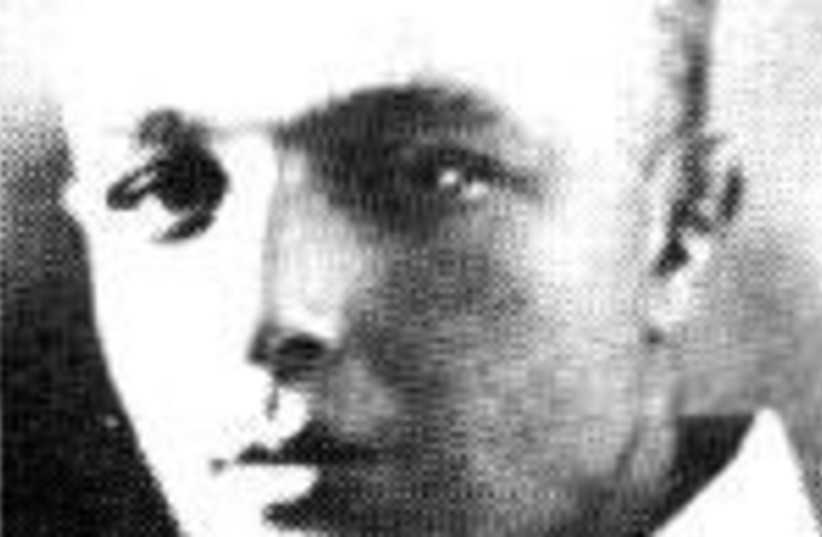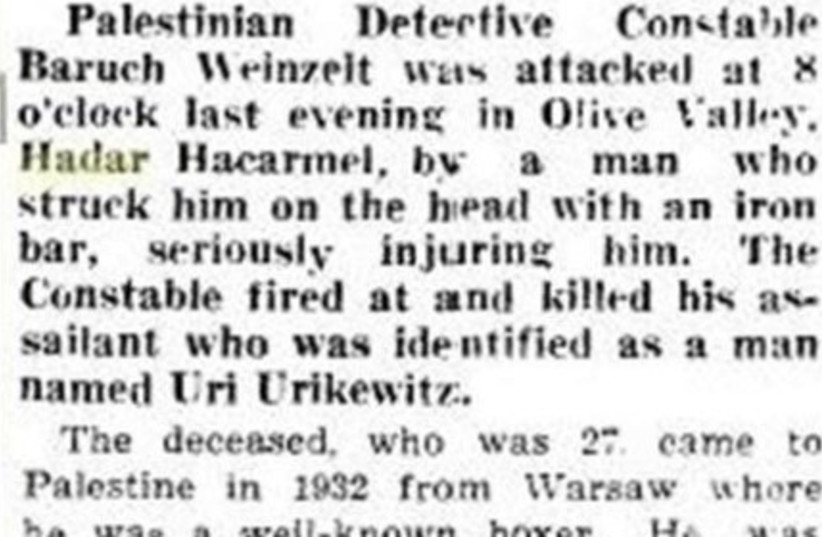Case File S.R. 304/39 51/39 of the Palestine Police Force, dated October 23, 1939, recently uploaded by Israel’s State Archives, deals with a manslaughter event that took place two weeks earlier on the evening of October 12, just after 8 p.m., near Ben-Shemen Street in Haifa, parallel to Ahad Ha’am Street.
Responding to a call from a concerned woman living on the street at two minutes past the hour of eight, Supt. Flanagan and a party went out to the scene, arriving within a quarter of an hour. There they found Criminal Investigation Dept. (CID) Constable Baruch Weinfeld, still dazed from being struck on the head with a blackjack. Nearby was a body. A shot to the head had killed the assailant.
Weinfeld related that he was descending the steps from the direction of the Technion when two persons accosted him. One then fled, never to be seen again. The other fled up the steps but was forced to return as several persons barred his retreat. Feeling threatened still, Weinfeld shot in the direction of his assailant. The bullet, entering the skull on the left side just above the ear, killed him.
The dead man turned out to be a special constable by the name of Joseph (Uri) Urkievitz, aged 28 and residing at 50 Masada Street less than 350 meters away.
URKIEVITZ WAS born in Warsaw in 1911 into a Zionist and Hebrew-educating family. He spent much of his youth street-fighting and eventually became a boxing champion of the city. He participated in the 1932 Maccabiah Games in Tel Aviv, winning first place. He gained an immigration certificate and stayed on in the country. His sister was a member of Kibbutz Ein Shemer of Hashomer Hatza’ir, although he had been in a group of Revisionist youth in Warsaw.

His physical abilities led him to become a coach at a Maccabi sports club, and eventually he was inducted into the Hagana. Later, he was transferred to the secret PUM unit. PUM (abbreviation of Pe’ulot Meyuhadot) acted as a covert squad engaged into counterterrorism against the Arabs as well as actions in the sphere of clandestine immigration by ship, the Aliyah Bet. During one incident, when an Arab woman became hysterical as they placed dynamite in her house, Urkievitz soothed her and led her out, and only then was the fuse set.
The PUM evolved in reaction to increased Arab terrorism in the North. In January 1939, after a Jewish bus was fired upon, Hagana members entered a tent belonging to the suspected Arab Ein-Bida’ah tribe and killed several of the occupants, including a woman and a child. On the night of February 14, Arab terrorists killed David Soltas in his bed in Kiryat Amal (Tivon). Gita, his pregnant wife, escaped injury. Their daughter Daliah was born later that year.
A Hagana squad of eight led by Levy Avrahami conducted a reprisal raid on the Arab-Zebiat tribe and killed two men and a woman. PUM was officially founded three months later and headed by Munya Mardor. Another collective punishment raid was done on June 13 after the murder of a train conductor on May 26. Five Arabs were summarily shot dead in Balad al-Sheikh village.
The adopting of the tactic of indiscriminate anti-Arab terrorism was unsettling to certain Hagana quarters. Yohanan Ratner’s resignation as Haifa Hagana chief was tied to the uncontrolled independence the Haifa branch permitted itself. Mapai’s Central Committee members also felt they were in the dark. Ethical questions were aroused. In fact, a year earlier, when Eliyahu Golomb, the Hagana head, met Ze’ev Jabotinsky in London on July 10, Jabotinsky had pointed to a few rogue Hagana operations as justification for the Irgun’s policy of “breaking the line of self-restraint.”
As Meir Chazan details in his 2009 study, “The Dispute in Mapai over ‘Self-Restraint’ and ‘Purity of Arms’ During the Arab Revolt,” 30 of the 80 Jews murdered during 1936 died in August. The Mapai Central Committee met on August 22 and 24 to discuss the issue.
Golomb argued there that it was no longer a matter of Yishuv security that headed the agenda but “the question of our existence in the country.” He further said that the time had come to abandon the policy of restraint, since “a war was being fought between two peoples over the future of the country.” In the end, his advice was not followed, yet there existed dissent in the ranks, and it is on this background that the events in Haifa developed.
Although Arab violence declined after the May 17 White Paper, following the murder near the village of Lubya of Binyamin Gershon, a driver from Afikim, again the PUM acted, this time on June 20 at Lubya, some 10 kilometers west of Tiberias near today’s Givat Avni.

Among those participating in the raid were Shlomo Shamir, Yigal Allon, Yossi Harel and David Shaltiel, all to become quite senior officers in the Hagana and Palmah.
The plan was to select one impressive house and fire into it. One Arab was shot dead on the way in and another two women and a man were killed after grenades were thrown through the windows. Two children were injured. Davar newspaper, presuming it was an Irgun operation, lashed out in its June 22 editorial at the “horrifying crime... whose perpetrators have lost the last vestige of human feeling.”
Another front opened after Roderick Christopher Musgrave, an assistant inspector of the CID, was charged with penetrating the Aliyah Bet operations and began to achieve success. After a five-year hiatus when the Hagana brought in but one ship and the Revisionist movement, starting in earnest in 1937, had brought in a half-dozen, operations moved into high gear.
However, information acquired by the Hagana’s intelligence unit indicated that details of the arrival of ships, originating from sources in Europe, were being obtained by the British from Jews. Suspicion fell on, among others, Weinfeld, who had just recently returned from Poland. The “illegal” ship had been tracked by airplanes and boarded.
It was then decided to punish Weinfeld. Urkievitz was assigned to the job, and Haim Laskov, who became the IDF’s fifth chief of staff, its first soldier’s ombudsman and a member of the post-Yom Kippur War Agranat Commission, was his reported companion.
As we know from the police file, Weinfeld escaped harm, Laskov managed to get away, and Urkievitz was killed. Musgrave eventually became the deputy to chief secretary John V.W. Shaw and died in the King David Hotel explosion in July 1946.
During the spring and summer of 1940, the PUM veterans eliminated Oscar Oppler, Moshe Sabatani, Yitzhak Sharanski, Walter Strauss and Moshe Yaakov Marcus for either revealing arms caches or immigration details to the British.
AS TO what happened eventually to Weinfeld, two additional attempts were made on his life as the PUM was now seeking revenge. As Haaretz published on April 9, 1940, a half-dozen shots were fired at him at the corner of Gideon and Masada streets, yet he escaped.
According to file 169/148 of the War Office: British Forces, Middle East: War Diaries, Second World War: Palestine and Trans-Jordan: G Intelligence (September 1939-December 1940), on June 26, 1940, “Detective Constable Weinfeld was shot dead in Haifa by Jewish terrorists.” They were Hillel Uldak and Dov Goldman.
Aged 26, recently married to Yonah and a father, he was buried in Haifa’s Old Cemetery, some 48 rows from Urkievitz. No mention of his death appeared in the Hebrew press.
